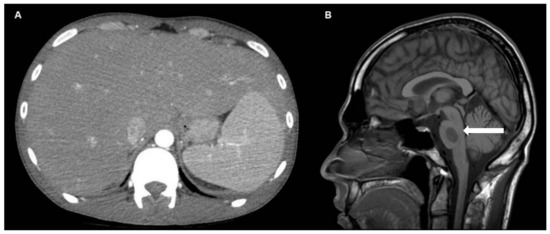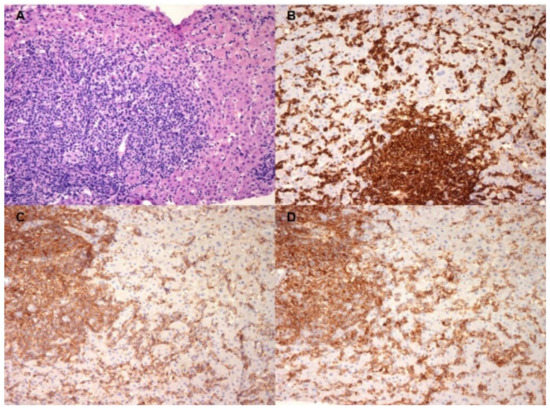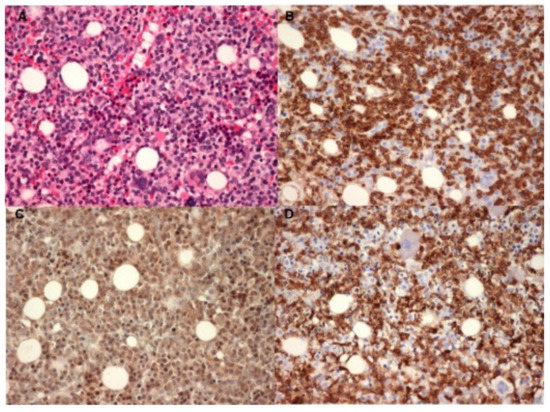Abstract
We herein report a case of hepatosplenic T-cell lymphoma (HSTCL) incidentally found in a 30-year-old man who came to the emergency department after an ankle trauma. At admission, laboratory tests revealed abnormal liver enzymes and pancytopenia, and imaging showed mild hepatosplenomegaly. During hospitalization, the patient’s clinical condition worsened rapidly, with a concomitant increase in cholestatic enzymes, severe jaundice, and the worsening of pancytopenia. Causes of liver injury, including many infectious diseases, were explored until the diagnosis of HSTCL was made by liver and bone marrow biopsies. Subsequently, the patient underwent six cycles of chemotherapy with a CHOP (cyclophosphamide, hydroxydaunorubicin, oncovin and prednisone or prednisolone) regimen and one with Hyper-CVAD (fractionated cyclophosphamide, vincristine, doxorubicin, dexamethasone) but, despite this aggressive treatment, died due to disease progression 2 months after diagnosis. This rare disease should be considered in the diagnostic workup of acute cholestatic hepatitis presenting with concomitant hepatosplenomegaly and cytopenia.
1. Introduction
Hepatosplenic T-cell lymphoma (HSTCL) is an aggressive and uncommon type of peripheral T-cell lymphoma that represents less than 1% of non-Hodgkin lymphomas [1]. It is more frequent among adolescents and young adults, with a median age of 35 years and a male predominance (male to female ratio 9:1) [1,2]. Often, HSTCL derives from gamma-delta T-cells, but in about 20% of cases T-cells express alfa-beta TCR (T-cell receptor), in which case the disease seems to have a worse prognosis [2]. Moreover, neoplastic T-cells are positive for CD2, CD3, CD7, and CD56 in two-thirds of cases, and only in a subset of CD8, whereas they are not expressed for CD1a, CD5, CD10, BCR or TdT (terminal deoxynucleotyl transferase) [3]. Its pathogenesis is not completely understood, but is believed to involve a polyclonal expansion of T-cell receptor types caused by the excessive antigenic stimulation of TCR and a subsequent series of genetic and additional transforming events including the up-regulation of the JAK/STAT pathway, mutations in chromatin modifiers, and the presence of isochromosome 7q and/or trisomy 8 that results in neoplastic monoclonal proliferation [4]. Long-term immunosuppression has been recognized as an important factor in the pathogenesis of HSCL; indeed, up to 20% of patients have a history of organ transplantation, immune disorders, or treatment with immunosuppressive agents [4]. Its clinical features are related to the infiltration of the spleen, liver and bone marrow by neoplastic T-cells, resulting in marked hepatosplenomegaly at presentation, with no or minimal peripheral lymph node involvement [2]. Patients usually manifest anemia, jaundice and constitutional or “B” symptoms (fever, weight loss, drenching night sweats). The main laboratory findings include cytopenia, elevated serum levels of serum lactate dehydrogenase (LDH) and beta-2 microglobulin, and abnormal liver cytolytic and cholestasis enzymes. Peripheral blood lymphocytosis occurs in less than 10% of patients [5]. The diagnosis of HSTCL is often challenging because of its rarity; differential diagnoses include other lymphoid neoplasms such as T-cell large granular lymphocytic leukemia, NK-cell leukemia, T-lymphoblastic leukemia type II, enteropathy-associated T-cell lymphoma, myelodysplastic syndrome, and other non-neoplastic diseases such as tuberculosis, mononucleosis, and acute hepatitis [6]. The prognosis of this neoplasm is still poor despite chemotherapy treatments, even though there is recent interest in the use of hematopoietic stem cell transplantation (HSCT), and other novel therapeutic approaches such as target therapy may be used in the future [7]. Our report describes a case of a young man affected by a rare disease that mimicked hepatocellular type hepatitis with cholestatic progression. It highlights the importance of considering such rare and aggressive diseases in the differential diagnosis of acute liver damage and cholestasis of unknown origin.
2. Case Report
A middle-aged patient without comorbidities was presented to the Emergency Department of Ferrara Hospital with an ankle injury from a road trauma. Initial laboratory work revealed abnormal liver enzymes: alanine aminotransferase (ALT) 1140 U/L (normal values < 43 U/L), aspartate aminotransferase (AST) 1294 U/L (n.v. < 35 U/L); alkaline phosphatase (ALP) 292 U/L (n.v. 50–150 U/L), gamma-glutamyl transferase (GGT) 244 U/L (n.v. 6–28 U/L); total bilirubin 5.28 mg/dL, direct bilirubin 3.19 mg/dL and pancytopenia (Hb 9.8 g/dL, WBC 1.9 × 109/L with 39% lymphoid cells, platelet count 167 × 109/L). Other relevant laboratory parameters of the patient were: elevated C reactive protein 16.5 mg/L (n.v. < 10 mg/L), LDH 391 U/L (n.v. 140–280 U/L) and beta-2-microglobulin 6.3 mcg/mL (n.v. 1.2–2.7 mcg/mL); procalcitonin, INR and renal function within normal limits. He presented with a low-grade fever (37.5 °C) and tachycardia (105 bpm). Imaging studies excluded intra-abdominal organ injury and revealed mild hepatosplenomegaly. No lymphadenopathies were reported.
Thereafter, the patient was referred to the Gastroenterology Department for further investigation. Drug ingestion, alcohol consumption and high-risk behaviors were excluded. Tests for mycoplasma, brucella, legionella, bartonella, leptospira, cytomegalovirus, Epstein–Barr virus, hepatitis A, B, C and E, and parvovirus B19 were all negative. Infectious Mononucleosis, Rapid Test, Serum (MONOS) was negative. Screening tests for HIV, leishmaniasis, tuberculosis, histoplasmosis, and common metabolic and autoimmune disorders were negative, as well as the rest of the blood, urine and stool cultural examinations. Empirical and serology-guided antimicrobial therapies due to the evidence of low-title IgM chlamydia pneumoniae and herpes simplex antibodies detected during diagnostic work-up were both ineffective, and they did not show any worsening effect on cholestasis trends either. A new CT scan of the chest, abdomen and pelvis confirmed a homogeneously enlarged liver (long axis, 21 cm) and splenomegaly (15 cm), without peripheral lymphadenopathy (Figure 1A). Flow cytometry and an immunophenotyping peripheral blood smear were performed, showing only a decreased CD4+/CD8+ ratio (0.97) without circulating clonal lymphoid cells. After 20 days of hospitalization, the patient developed fatigue, notable weight loss (10 kg), fever (up to 39 °C), an abrupt increase in serum bilirubin and ALP (up to 27 mg/dL and 710 U/L, respectively) without bile duct dilation, and a worsening of pancytopenia; meanwhile AST and ALT levels progressively reduced over three weeks (down to 325 U/L and ALT to 252 U/L, respectively). After consultation with hematologists, liver (Figure 2) and bone marrow (Figure 3) biopsies were performed revealing sinusoidal infiltration by medium-sized lymphoid cells positive for CD3 and CD2 and negative for B-cell-associated antigens (CD4 and CD8) and CD5 (T-cell lymphoma phenotypic aberrancy) at the immunohistochemical staining. The immunophenotype and the clinical and radiological findings were thus compatible with hepatosplenic T-Cell lymphoma (HSTCL). The patient started CHOP chemotherapy (cyclophosphamide, hydroxy doxorubicin, vincristine, prednisone) with a transitory clinical and hematologic response. Autologous stem cell transplantation was considered. However, less than 2 months after diagnosis, the patient presented with a central pontine localization of the disease (Figure 1B) and, despite new aggressive treatment with multiagent chemotherapy (Hyper-CVAD), he died from complications of the refractory disease.

Figure 1.
(A) Coronal CT scan of the abdomen homogeneously showing hepatomegaly and splenomegaly; (B) Sagittal magnetic resonance imaging view of central pontine localization of T-Cell lymphoma (white arrow).

Figure 2.
(A) Liver biopsy demonstrating intense intralobular and intra-sinusoidal infiltration by monotonous neoplastic lymphoid cells (H&E ×100); (B) neoplastic cells in the liver biopsy showing CD3 immunostaining (×100); (C) liver biopsy: CD2 immunostaining of the neoplastic infiltrate (x100); (D) liver biopsy: CD7 immunostaining of the neoplastic infiltrate (×100).

Figure 3.
(A) Liver biopsy demonstrating intense intralobular and intra-sinusoidal infiltration by monotonous neoplastic lymphoid cells (H&E ×100); (B) neoplastic cells in the liver biopsy showing CD3 immunostaining (×100); (C) liver biopsy: CD2 immunostaining of the neoplastic infiltrate (×100); (D) liver biopsy: CD7 immunostaining of the neoplastic infiltrate (×100).
3. Discussion
Cholestatic hepatitis is an intrahepatic cholestasis resulting from hepatocellular functional defects and/or obstructive lesions of the intrahepatic biliary tract. Clinical and biochemical presentation is characterized by fatigue, pruritus, jaundice and increasing in serum transaminase, ALP, GGT, and hyperbilirubinemia at more advanced stages. The acute onset of cholestatic hepatitis may be observed in viral infection, drug–alcohol toxicity, sepsis–endotoxemia, acquired and hereditary cholestatic disorders, immune-mediated diseases, vascular disorders, and benign or malignant infiltrating disorders such as lymphomas [8]. Liver biopsy is an important diagnostic tool in the cholestasis of unknown origin, especially when a disorder is suspected without direct involvement of the bile ducts, such as cirrhosis, hepatic granulomas, nodular regenerative hyperplasia, sinusoidal dilatation, and storage or infiltrative liver diseases. HSTCL is a primary non-Hodgkin lymphoma of the liver that is an unusual cause of intrahepatic cholestasis by a mixed pathological mechanism [8]. It is a rare entity, usually manifesting with constitutional “B symptoms”, and with signs of liver and spleen involvement such as cytopenias, liver enzyme alteration, or progressive jaundice. The diagnostic work-up requires a full liver and hematological assessment with laboratory tests and radiological imaging investigations, particularly with ultrasound and CT scans. At first, in fact, B-symptoms and cytopenia may be more suggestive of a diagnosis of acute leukemia [4]. Therefore, clinical suspicion should be raised in cases of isolated hepatosplenomegaly without lymphadenopathies; in our case, the abdominal CT-scan reported a similar situation, with no substantial lymph node involvement. A definitive diagnosis, similar to other lymphomas, requires histological confirmation. The diagnosis of HSTCL is usually challenging because of its rarity in clinical practice and the chance of conflicting diagnosis with other hematological disorders. The infiltrative and infectious nature of the disease makes it difficult to handle, particularly with mononucleosis, as shown in our case in which a deep work-up to exclude other causes was performed. Moreover, our patient presented to the hospital for a road trauma, and only subsequently was the diagnosis of lymphoma made; this is a peculiarity of our case, and may be explained by a pre-hospitalization indolent course of the disease that is reported in only one case report, making diagnosis even more difficult [9]. Finally, the initial presentation of hepatocellular type liver injury with high transaminases levels followed by rapid progression to a cholestatic pattern makes our case peculiar. Although the liver is the primary organ involved, we have found no case reports focused on the pattern of liver injuries mimicking rapid progressive cholestatic hepatitis. On the other hand, our findings are in line with data reported in a recent study of 40 cases of hepatic involvement with T-cell neoplasms where HSTCL was predominantly characterized by a cholestatic pattern of liver disfunction (n = 9/14, 64%) compared to other T-cell neoplasms [10]. In contrast, Maya Petrova et al. reported a case of HSTCL in a young immunocompetent man with normal liver function tests despite the portal and sinusoidal infiltration of clonal lymphoid cells [11]. The different clinical manifestations among patients with HSTCL can be partly explained by the pattern of liver infiltration (sinusoidal, portal predominant and sinusoidal, portal and lobular, mass forming) [10]. Our patient developed a central nervous system (CNS) invasion that is a rare and poor prognostic feature of the disease [12], suggesting an advanced stage of the disease. This may explain the patient’s rapid worsening of clinical condition and premature death. In our case, the acute clinical presentation with hepatosplenomegaly, abnormal liver chemistries with cholestasis, and fever without the presence of lymphadenopathy or mass lesions led us to focus more on hepatic inflammatory diseases related to mixed liver injury (both hepatocellular and cholestatic). However, the rapid worsening of clinical condition with severe pancytopenia and abrupt liver cholestatic enzymes without bile duct dilation, and other laboratory clues such as elevated beta-2-microglobulin, prompted us to consider other less common diseases.
4. Conclusions
Our case describes an unusual presentation of HSTCL mimicking the acute onset of hepatitis in a young immunocompetent man with hepatosplenomegaly, jaundice, and systemic symptoms without substantial peripheral lymphadenopathy. Even if rare, this clinical entity should be promptly considered in the setting of acute liver injury, especially in young men with features of liver and spleen morphological alterations. Gastroenterologists and hepatologists must be aware of this clinical entity, since a definitive diagnosis could lead to rapid chemotherapy initiation with the aim of inducing remission, eventually followed by early stem cell transplantation.
Author Contributions
Conceptualization and data curation, F.M., R.S., R.G. and G.M.; data acquisition and interpretation, writing—review and editing F.M., L.V.A. and G.M. All authors have read and agreed to the published version of the manuscript.
Funding
This research received no external funding.
Institutional Review Board Statement
Not applicable.
Informed Consent Statement
Patient consent was waived due to Local Ethical Committee Permission.
Data Availability Statement
Not applicable.
Conflicts of Interest
The authors declare no conflict of interest.
References
- Campo, E.; Harris, N.L.; Jaffe, E.S.; Pileri, S.A.; Stein, H.; Thiele, J.; Vardiman, J.W. WHO Classification of Tumours of Haematopoietic and Lymphoid Tissues, 4th ed.; IARC Press: Lyon, France, 2008; Volume 2. [Google Scholar]
- Yabe, M.; Medeiros, L.J.; Tang, G.; Wang, S.A.; Ahmed, S.; Nieto, Y.; Hu, S.; Bhagat, G.; Oki, Y.; Patel, K.P.; et al. Prognostic factors of hepatosplenic T-cell lymphoma (HSTCL): A clinicopathologic, immunophenotypic, and cytogenetic analysis of 28 patients. Am. J. Surg. Pathol. 2016, 40, 676–688. [Google Scholar] [CrossRef] [PubMed]
- Macon, W.R.; Levy, N.B.; Kurtin, P.J.; Salhany, K.E.; Elkhalifa, M.Y.; Casey, T.T.; Craig, F.E.; Vnencak-Jones, C.L.; Gulley, M.L.; Park, J.P.; et al. Hepatosplenic alphabeta T-cell lymphomas: A report of 14 cases and comparison with hepatosplenic gammadelta T-cell lymphomas. Am. J. Surg. Pathol. 2001, 25, 285–296. [Google Scholar] [CrossRef] [PubMed]
- Yabe, M.; Miranda, R.N.; Medeiros, L.J. Hepatosplenic T-cell Lymphoma: A review of clinicopathologic features, pathogenesis, and prognostic factors. Hum. Pathol. 2018, 74, 5–16. [Google Scholar] [CrossRef] [PubMed]
- Vose, J.; Armitage, J.; Weisenburger, D. International peripheral T-cell and natural killer/T-cell lymphoma study: Pathology findings and clinical outcomes. J. Clin. Oncol. 2008, 26, 4124–4130. [Google Scholar] [PubMed]
- Shi, Y.; Wang, E. Hepatosplenic T-cell lymphoma: A clinicopathologic review with an emphasis on diagnostic differentiation from other T-cell/natural killer-cell neoplasms. Arch Pathol. Lab. Med. 2015, 139, 1173–1180. [Google Scholar] [CrossRef] [PubMed]
- Travert, M.; Huang, Y.; De Leval, L.; Martin-Garcia, N.; Delfau-Larue, M.H.; Berger, F.; Bosq, J.; Brière, J.; Soulier, J.; Macintyre, E.; et al. Molecular features of hepatosplenic T-cell lymphoma unravels potential novel therapeutic targets. Blood 2012, 119, 5795–5806. [Google Scholar] [CrossRef] [PubMed]
- Chazouillères, O.; Housset, C. Intrahepatic cholestasis. In Textbook of Hepatology: From Basic Science to Clinical Practice; Blackwell: Oxford, UK, 2007; pp. 1481–1500. [Google Scholar]
- Amin, S.; Findeis, S.K.; Whiteley, A.; Krause, J.R. An unusual presentation of an uncommon lymphoma, hepatosplenic T-cell lymphoma. In Baylor University Medical Center Proceedings; Taylor & Francis: Dallas, TX, USA, 2019; Volume 32, pp. 129–130. [Google Scholar]
- Li, P.; Zhang, D.; Zhou, J.; Li, P.; Shen, Y.; Pan, Z.; Evans, A.G.; Liao, X. Hepatic involvement by T-cell neoplasms: A clinicopathologic study of 40 cases. Hum. Pathol. 2020, 106, 1–12. [Google Scholar] [CrossRef] [PubMed]
- Petrova, M.; Gomes, M.M.; Carda, J.P.; Pereira de Moura, J. Hepatosplenic T-cell lymphoma in a young immunocompetent man. BMJ Case Rep. 2016, 2016, bcr2016214414. [Google Scholar] [CrossRef] [PubMed] [Green Version]
- Harada, Y.; Kato, S.; Komiya, H.; Shirota, T.; Mukai, K.; Hayashi, T. Primary omental gamma/delta T-cell lymphoma involving the central nervous system. Leuk. Lymph. 2004, 45, 1947–1950. [Google Scholar] [CrossRef] [PubMed]
Publisher’s Note: MDPI stays neutral with regard to jurisdictional claims in published maps and institutional affiliations. |
© 2022 by the authors. Licensee MDPI, Basel, Switzerland. This article is an open access article distributed under the terms and conditions of the Creative Commons Attribution (CC BY) license (https://creativecommons.org/licenses/by/4.0/).